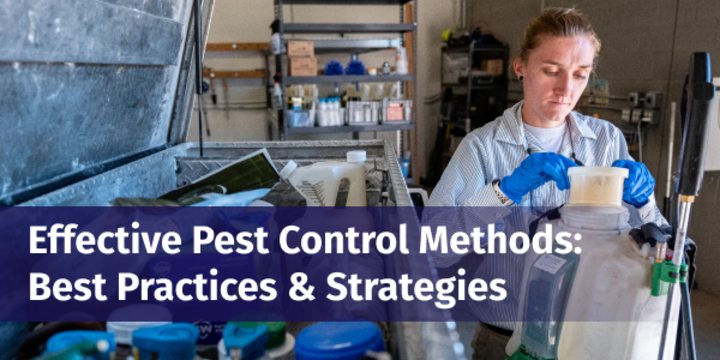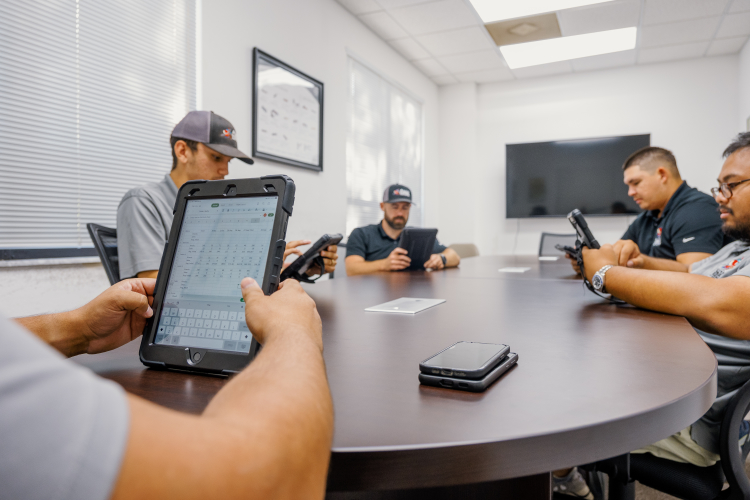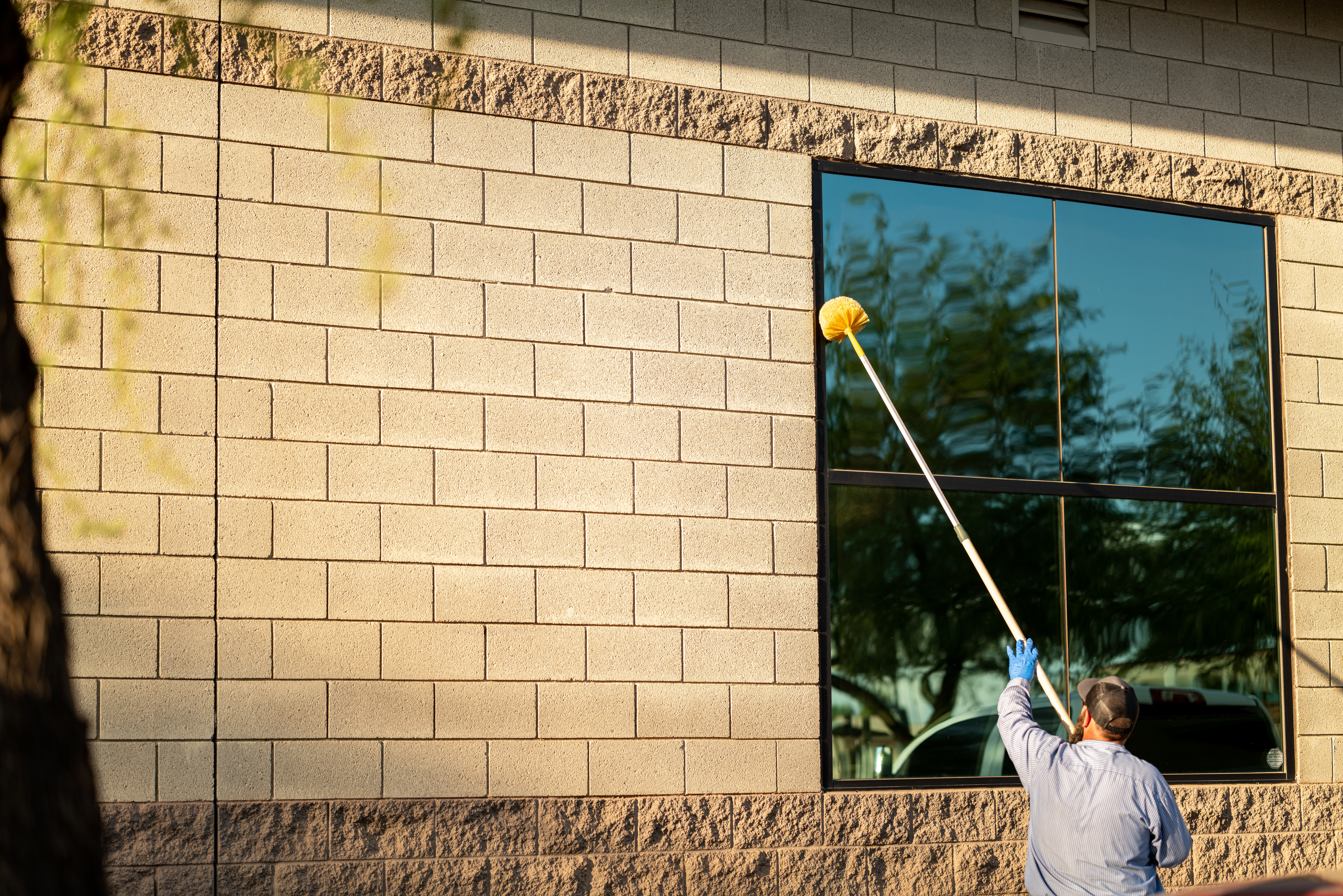Effective Pest Control Methods: Best Practices & Strategies

Pest control methods fall into a few categories:
Physical pest control, such as traps and barriers
Chemical pest control, such as pesticides and rodenticides
Biological pest control, such as predatory and parasitic insects
Integrated pest management, or IPM, combines elements of all three to holistically manage pests across an ecosystem. For instance, a homeowner practices IPM when they release ladybugs, spray neem oil, and plant marigolds to manage garden pests.
Staying current with these pest control methods sets your business up for success. The more pest control methods you have to choose among, the more personalized and effective solution you can deliver each customer.
Physical Pest Control
Physical pest control methods comprise a wide range of options. Some are common sense, such as sealing cracks and setting traps.
But others are unexpected, like the way some pest control pros swear by using a vacuum cleaner. Knowing what to use and when goes a long way toward improving your field service operations.
Barriers and Exclusion Methods
Barriers and other exclusion methods create a boundary pests can’t or won’t cross. For example, a window screen creates a physical boundary that keeps bugs out while air still flows through. A barrier spray, by comparison, creates a chemical boundary that repels insects from a home’s foundation.
Barriers and exclusion methods are most effective with pests that take predictable paths. Take rodents and roaches, who’ll squeeze beneath doorways to gain entry to homes. A simple door sweep seals that space, keeping both pests outside.
Once you know pests’ preferred routes to block off, you can work backward to put more pressure on them. If you find out the roaches are coming from an infestation under the sidewalk, you can position bait stations to hit the roaches closer to home.
Traps and Capture Devices
Traps and capture devices eliminate pests by ensnaring or deceiving them. As Saturday Night Live showed in its spoof ad for Bug Off, there’s a certain kind of satisfaction that comes from catching pests with a trap. Common examples of trap and capture devices include:
Glue boards for catching mice and crawling insects
Dishes of beer for trapping and drowning garden pests like slugs
Refillable bait stations for trapping rats
Traps capture a pest by using something against it, such as luring it with a piece of food or snaring it along its regular route. That means, like with barriers and exclusion methods, traps are most useful when you can predict how a pest population moves – or at least its general whereabouts – so you can catch its attention with some bait.
Mechanical Removal Techniques
Mechanical techniques directly kill or remove a pest without the use of chemical or biological agents. That efficiency, combined with the reality that mechanical techniques usually best fit small-scale jobs, makes mechanical pest removal appeal to homeowners.
Mechanical techniques can be as simple as picking beetles off plants, scraping aphids off flowers, or tilling the soil to bring grubs to the surface. That manual labor doesn’t appeal to everyone, but there’s an upside to it. Mechanical techniques create minimal impact on the surrounding environment, something that’s important to eco-conscious customers.
Mechanical techniques overlap with other forms of pest control, too. A classic example is the mousetrap.
Vacuuming and Suction Methods
A vacuum is a powerful pest control tool. Vacuums inhale large amounts of bugs, able to greatly reduce insect infestations such as bed bugs, cockroaches, and termites. But in the hands of an experienced exterminator, a vacuum also:
Removes droppings and shell bits so they don’t cause a health hazard
Captures insects for identification with the help of special attachments
Handles bugs that can’t or shouldn’t be handled, like stink bugs
Vacuums and suction tools work best in a support role, making them great for an integrated pest management plan. For instance, vacuuming crevices does more than pull insects from hard-to-reach places. It also reduces how much insecticide you need to use because there’s less dust and lint in the way. And because the vacuum pulls up bits of food, insects have an even harder time surviving.
Pick a HEPA (high efficiency particulate air) unit, which will minimize how much dust you stir. The HEPA filter will capture tiny airborne allergens, leaving you and your customers confident in a cleaner home.
Biological Pest Control
Biological pest control leverages nature’s help to manage pests. This can be as straightforward as releasing ladybugs to eat aphids. But it can also mean reinforcing biological mechanisms already in place, such as increasing nematode numbers.
Biological pest control methods get more complex, too, with microbe-based solutions engineered from bacteria.
Predatory Insects and Invertebrates
Predatory insects and invertebrates turn the predator-prey relationship in your favor. These beneficial organisms are natural enemies of unwanted pests, like a dog or cat ready to go after a mouse. Some examples of predatory insects include:
Certain types of beetles that eat termites
Predatory mites that feed on spider mites
Green lacewing larvae that eat aphids and thrips
Predatory insects and invertebrates are great at what they do, but they have limitations. To start, some customers won’t be comfortable with the idea, particularly if they fear it’ll mean more bugs coming into their homes. Also, some predators have narrow feeding habits while others are more general, eating beneficial insects and unwanted bugs alike.
Keep in mind, too, that customers may call about an insect that’s already performing predatory pest control. A few house centipede or spider sightings could mean the insects are snacking on roaches or silverfish somewhere in the house.
Parasitoids and Parasitic Nematodes
Only around 10% of insects are parasitoids, many of them flies and wasps. But they play a big role in the natural world. Whereas a parasite must find a host to which to attach, parasitoids begin life attached to another insect, usually as eggs deposited in the host’s body.
Parasitic nematodes work similarly and offer more as a biological pest control method. Nematodes are microscopic worms found in the soil. Some species are helpful, others harmful. Helpful varieties, such as the roach-eating nematode Steinernema carpocapsae, feed by injecting their prey with a toxic bacteria that breaks insects down into a meal.
Because they’re microscopic, nematodes can be sprayed by the millions. You can cover a lot of ground quickly to target fleas, grubs, gnats, and more. Just be sure you’re applying the right species, as the wrong species of nematode can be destructive.
Note nematodes are living organisms. They don’t have a long shelf life, and they have to be applied in the right conditions. Soil should be moist and aerated, and spray should be applied in the evening or morning when temperatures are cooler and sunlight is lower. Also note that nematodes take time to work and may require repeat applications.
Microbial Control Agents
Microbial pest control harnesses microorganisms and pathogens – bacteria, viruses, fungi – as a means to suppress insect populations. The microbe is engineered into a biological pesticide that’s applied to the soil. Insects ingest the pesticide, introducing a microbe that kills from the inside out.
Bacillus thuringiensis, or Bt, is one of the more well-known types of microbial control agents. Found in more than 130 pesticide products, this naturally occurring soil bacteria has been developed into strains that target specific insects such as beetles, flies, and mosquitoes.
Microbial pesticides are a smart choice for eco-friendly pest control. The Environmental Protection Agency (EPA) notes their advantages, from low toxicity to people and animals to high effectiveness in low doses.
Still, there are some drawbacks. Like with nematodes, microbial control agents are less shelf-stable than conventional pesticides. And though microbial solutions’ narrow host range makes them safer, it may also mean you need a wide variety to be prepared.
Chemical Pest Control
Chemical pesticides are powerful against all kinds of common pests – so powerful they must be used responsibly. More and more, that means combining pesticides with other methods as part of an integrated pest control plan. That way, you get maximum effect from a minimal dose of pesticide.
When considering a pesticide, start by reading the label closely. The product should be something you feel safe handling and recommending to customers. Make sure you’re confident following the instructions and application techniques.
Also ask yourself how well the new pesticide would fit into your service routine. By making sure you feel comfortable at all stages of using the pesticide, it’s more likely you’ll keep customers, their children, and pets safe.
Types of Chemical Pest Control Methods
Pesticides break down into three main types of chemical pest control:
Insecticides are chemicals that target insects. Some kill insects instantly or over time. Other insecticides act in different ways, such as insect growth regulators (IGRs) that disrupt insect life cycles.
Rodenticides are chemicals made for killing rodents, such as rat poison. Rodenticides are harmful and even fatal to more than rodents, including pets.
Herbicides are considered pesticide because weeds are considered pests. Considering Americans average about 3.4 hours per week and $55 per month on their lawns, weeds are definitely pests.
The growing demand for insecticide reinforces the importance of using it responsibly. The global insecticides market is on pace to reach $22 billion by 2030.
Factors When Selecting Chemical Pest Control Methods
When researching new pesticides to potentially use, several outside factors should be taken into consideration, too:
Safety precautions: Do you have all the personal protective equipment (PPE) required? Do you have the proper ventilation and equipment to mix and apply the pesticide? Making sure you can meet the product's safety standards minimizes chance of exposure.
Environmental impact: Can you safely store unused product so there’s no risk of contamination? Can you safely dispose of used product? Do you have the ability to clean your tools immediately and keep service clothes separate from other laundry? Proper handling protects you and the environment from improper pesticide exposure.
Regulatory considerations: Pesticide use must comply with both state and federal regulations. The National Pesticide Information Center (NPIC) offers a directory to each state’s regulatory agency. It also lets you search by pesticide or ingredient.
Though it takes time to properly vet a pesticide, doing so protects human, animal, and plant life from potential great harm. The desire to responsibly use all pest control methods, not just pesticides, is a driving force behind the demand for integrated pest management.
Integrated Pest Management (IPM)
Integrated pest management, or IPM, emphasizes sustainable, long-term pest control by combining different techniques into a tailored plan. Its goals include:
Creating minimal impact on people and the environment
Designing a plan based on the overall ecosystem
Using nature’s own pest defenses as much as possible
One of the biggest benefits of IPM, especially in the eyes of customers, is the reduced use of pesticide. That’s reflected by this IPM program for a greenhouse from Oklahoma State University. Its 18-point plan emphasizes biological over chemical controls with subheadings such as “Horticultural Oils,” “Insect Growth Regulators,” and “Botanicals.”
IPM Core Practices
Because IPM is an ongoing effort, it operates from a handful of core practices. When done regularly, these practices incrementally build healthy environments that customers are proud to enjoy.
Pest identification is as simple as it sounds. IPM emphasizes treating only for observed and identified pest problems. A targeted approach like this keeps environmental impact low.
Scouting and monitoring for pests should be done routinely, anywhere from daily to weekly depending on the type of pest and the environment. Create a route, and note the places on the route to stop and check – under leaves, along a foundation, at bait stations.
Prevention means to assess the environment for vulnerable points and proactively address them. For instance, looking around a customer’s backyard for places mosquitoes could lay eggs.
Threshold-based decision-making relates to scouting and monitoring. Noticing a few wasps every now and then probably doesn’t warrant action. But seeing them every day and in increasing numbers means it’s time to locate and remove their nest.
Implementation of control methods means to choose what combination of physical, biological, and chemical techniques will most effectively manage the pest while creating the least disturbance to the environment. For instance, you might use a trap crop such as zinnia to attract Japanese beetles. Once they’re concentrated in one place, you could exterminate them with a small amount of insecticide.
Level Up Your Pest Control Business
Staying up-to-date on pest control methods gives you an edge over your competition. But more importantly, it gives you the confidence you’re offering the best service options to your customers. As you explore new methods of pest control, remember:
Prevention is key. Preventing pest infestations is easier than getting rid of them, so tell customers when sealing a crack or caulking a window would make a difference.
Identify the pest and tailor the control method. Know exactly what kind of pest you’re dealing with, and study the environment carefully as you come up with a treatment plan. It’ll save you time and money and lessen the chances of off-target impact.
Be persistent. Pest control is an ongoing effort, especially with an IPM approach. Keep notes and take pictures so you can document progress for yourself and your customers.
The complexity in just choosing a control method shows how demanding it is to run a pest control business. FieldRoutes, a ServiceTitan company, reduces complexity by automating your pest control operations.
FieldRoutes® pest control software streamlines manual tasks, giving you the technology to go paperless, customize agreements in the field, and more.
See how with a free demo.




